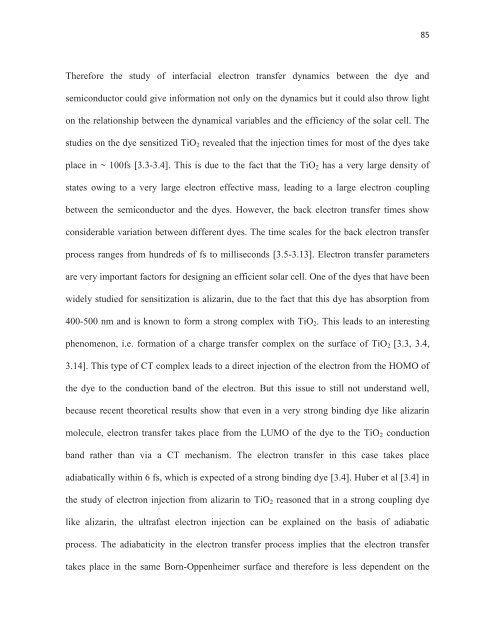CHEM01200604009 Sreejith Kaniyankandy - Homi Bhabha ...
CHEM01200604009 Sreejith Kaniyankandy - Homi Bhabha ...
CHEM01200604009 Sreejith Kaniyankandy - Homi Bhabha ...
Create successful ePaper yourself
Turn your PDF publications into a flip-book with our unique Google optimized e-Paper software.
85<br />
Therefore the study of interfacial electron transfer dynamics between the dye and<br />
semiconductor could give information not only on the dynamics but it could also throw light<br />
on the relationship between the dynamical variables and the efficiency of the solar cell. The<br />
studies on the dye sensitized TiO 2 revealed that the injection times for most of the dyes take<br />
place in ~ 100fs [3.3-3.4]. This is due to the fact that the TiO 2 has a very large density of<br />
states owing to a very large electron effective mass, leading to a large electron coupling<br />
between the semiconductor and the dyes. However, the back electron transfer times show<br />
considerable variation between different dyes. The time scales for the back electron transfer<br />
process ranges from hundreds of fs to milliseconds [3.5-3.13]. Electron transfer parameters<br />
are very important factors for designing an efficient solar cell. One of the dyes that have been<br />
widely studied for sensitization is alizarin, due to the fact that this dye has absorption from<br />
400-500 nm and is known to form a strong complex with TiO 2 . This leads to an interesting<br />
phenomenon, i.e. formation of a charge transfer complex on the surface of TiO 2 [3.3, 3.4,<br />
3.14]. This type of CT complex leads to a direct injection of the electron from the HOMO of<br />
the dye to the conduction band of the electron. But this issue to still not understand well,<br />
because recent theoretical results show that even in a very strong binding dye like alizarin<br />
molecule, electron transfer takes place from the LUMO of the dye to the TiO 2 conduction<br />
band rather than via a CT mechanism. The electron transfer in this case takes place<br />
adiabatically within 6 fs, which is expected of a strong binding dye [3.4]. Huber et al [3.4] in<br />
the study of electron injection from alizarin to TiO 2 reasoned that in a strong coupling dye<br />
like alizarin, the ultrafast electron injection can be explained on the basis of adiabatic<br />
process. The adiabaticity in the electron transfer process implies that the electron transfer<br />
takes place in the same Born-Oppenheimer surface and therefore is less dependent on the
















